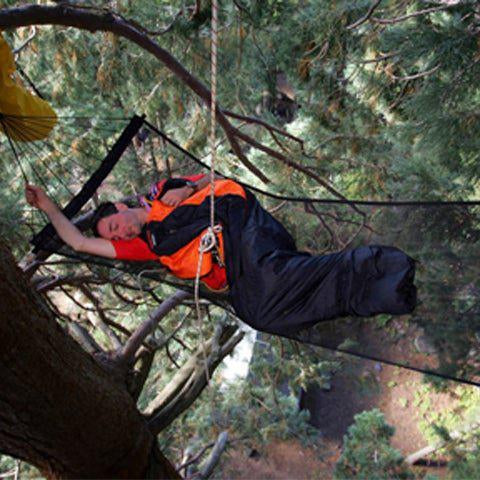Is it Healthy to Sleep in a Hammock | Guide by Simply Hammocks
Embracing Wellness: The Surprising Health Benefits of Sleeping in a Hammock
In the quest for restful sleep and holistic well-being, unconventional solutions often emerge, and one such contender is the humble hammock. The idea of sleeping in a hammock may raise eyebrows, but as we unravel the surprising health benefits backed by research and explore practical tips, you might find yourself swaying towards a new approach to slumber.
Watch Coalcracker's Guide to getting your best nights sleep in a hammock
See 5 Reasons to Use Your Hammock as a Bed
The Science Behind the Sway: Research Insights
-
Enhanced Sleep Quality:
- A study conducted by the University of Geneva found that the rocking motion of a hammock synchronizes brain waves, leading to a deeper and more restorative sleep. This rhythmic motion can enhance the quality of sleep, leaving individuals feeling more refreshed upon waking.
- A study conducted by the University of Geneva found that the rocking motion of a hammock synchronizes brain waves, leading to a deeper and more restorative sleep. This rhythmic motion can enhance the quality of sleep, leaving individuals feeling more refreshed upon waking.
-
Back Pain Relief:
- Research from the Journal of Physical Therapy Science suggests that hammock-like rocking can alleviate lower back pain. The gentle sway distributes pressure evenly, promoting spinal alignment and reducing discomfort.
- Research from the Journal of Physical Therapy Science suggests that hammock-like rocking can alleviate lower back pain. The gentle sway distributes pressure evenly, promoting spinal alignment and reducing discomfort.
-
Reduced Stress Levels:
- A study published in the International Journal of Neuroscience discovered that the rocking motion of a hammock induces a state of relaxation, reducing cortisol levels (the stress hormone) and promoting a sense of calm.
Tips and Tricks for Healthy Hammock Sleep:
-
Opt for a Quality Hammock:
- Choose a hammock made from durable materials with proper support. Consider hammocks with spreader bars for a flatter, more stable surface.
- Choose a hammock made from durable materials with proper support. Consider hammocks with spreader bars for a flatter, more stable surface.
-
Perfect the Hang:
- Ensure the hammock is hung at the right height and angle. The ideal angle is around 30 degrees from horizontal, providing a comfortable and supportive sleeping position.
- Ensure the hammock is hung at the right height and angle. The ideal angle is around 30 degrees from horizontal, providing a comfortable and supportive sleeping position.
-
Use Supportive Accessories:
- Add a pillow or cushion for neck support, and consider using a breathable fabric for the hammock to avoid overheating.
- Add a pillow or cushion for neck support, and consider using a breathable fabric for the hammock to avoid overheating.
-
Find Your Comfort Zone:
- Experiment with different lying positions until you find the one that feels most comfortable for you. Some prefer lying diagonally for a flatter sleep surface.
- Experiment with different lying positions until you find the one that feels most comfortable for you. Some prefer lying diagonally for a flatter sleep surface.
-
Practice Safe Entry and Exit:
- Master the art of getting into and out of a hammock safely to avoid accidents or falls. Practice makes perfect, so take your time until you're comfortable with the process.

- Master the art of getting into and out of a hammock safely to avoid accidents or falls. Practice makes perfect, so take your time until you're comfortable with the process.
FAQs: Unlocking the Mysteries of Hammock Sleep
Q: Can sleeping in a hammock cause back pain? A: When properly set up, sleeping in a hammock can actually alleviate back pain by promoting spinal alignment and reducing pressure on the lower back.
Q: How long does it take to get used to sleeping in a hammock? A: The adjustment period varies from person to person. Some adapt quickly, while others may take a few nights. Start with short sessions and gradually increase the duration.
Q: Can anyone sleep in a hammock, or is it only for certain sleeping positions? A: Hammocks accommodate various sleeping positions. Experiment with different angles and lying positions to find what suits you best.
Q: Are there any age restrictions for hammock sleep? A: Hammock sleep is generally suitable for all ages, but supervision is recommended for young children. Ensure the hammock is hung at a safe height for easy entry and exit.
In Conclusion: Hammocks and the Art of Serene Slumber
While the idea of sleeping in a hammock may initially seem unconventional, the blend of research-backed benefits and practical tips unveils a world of serene slumber. As you consider the possibilities, allow the gentle sway of a hammock to cradle you into a realm of deep, restorative sleep—a holistic approach to well-being that embraces the simplicity of nature.







